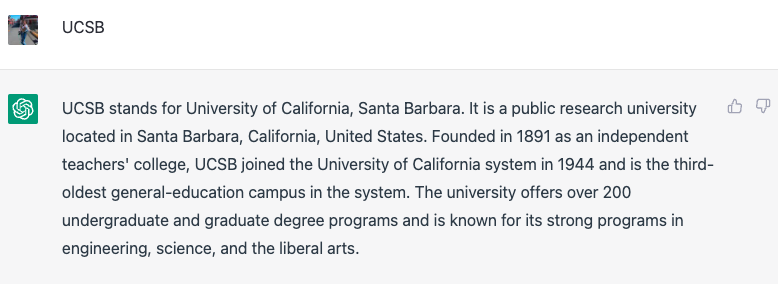Tia Trinh
Arts & Entertainment Co-Editor
Write a poem. Simple instructions, right? However, to a human, this might be a difficult endeavor. There are so many ways to write a poem, so many ideas to think about, so many literary stylistics to use — and the list continues on and on. But to an Artificial Intelligence (AI), writing a poem might only take a few seconds.
ChatGPT is one of the newest free AI bots that has become widely popular across the internet. Developed by the company OpenAI, ChatGPT was introduced as an AI that “interacts in a conversational way… to answer follow-up questions, admit its mistakes, challenge incorrect premises, and reject inappropriate requests.”
Input any sort of instructions and in a few seconds, the AI will cough up a response. So, to put it to the test, I asked the AI to “write a poem” for me:
Beneath the starry sky
A tree stands tall and strong
Its branches reaching high
As if to touch the dawn
The leaves rustle gently
In the cool night breeze
A symphony of nature
That never fails to please
The tree stands alone
But is not lonely
For it is a part of the world
And the world is its home
The moonlight filters through
And the tree glows with light
A beacon in the darkness
That guides us through the night
So let us stand tall
Like the tree beneath the stars
And let our branches reach high
For who knows how far
Not even a minute later, the words appeared on the screen. Stanzas of words haphazardly strung together became a poem that the AI titled “Starry Night.” It’s not difficult to tell that it’s not a very well-written poem. There is virtually no rhythm nor intention in the line breaks, and the rhyme could use some serious workshopping. Regardless of a writer’s criticism, it remains impressive that in just a few seconds, the AI was able to spit something out that has some potential to be a full-fledged poem.
The AI’s ability doesn’t stop there. Forbes notes that “ChatGPT has been able to generate intricate Python code and write college-level essays when given a prompt.”
In this modern age, the many applications of technology can be considered useful and even time-saving. In just seconds, the answers that someone is looking for are right at their fingertips. Input “UCSB” and, in no time, the AI offers a paragraph of information about the school.

However, while it may be fun to ask the AI to write stories or inform us about celebrities and fictional characters, new concerns have arisen about the use of these AI generators.
The most flashing concern is, no doubt: what does this mean for the future of art and education? Such recent advancements in technology have raised concerns about the use of AI for cheating, as, The New York Times points out, “many educators have predicted that ChatGPT, and tools like it, will spell the end of homework and take-home exams.”
Students might see this as an easy way out, but there are still other concerns, including the authenticity of AI-generated works, which scrape information from all sorts of sources scattered across the internet.
Other AI companies are facing lawsuits for stealing artists’ works. Most recently, three artists have raised a class-action lawsuit against Stability AI and Midjourney. According to The Verge, the artists, Sarah Anderson, Kelly McKernan, and Karla Ortiz “allege that these organizations have infringed the rights of ‘millions of artists’ by training their AI tools on five billion images scraped from the web ‘without the consent of the original artists.’”
Their case knocks on the ethical doors of what should and shouldn’t be used for AI sourcing, as well as its damage to the art industry. Such lawsuits spark debate about what people will consider original art to be, and how AI will affect the job industry as a whole in the future.
Despite being able to generate such a wide range of responses, the AI isn’t able to answer every input, and still retains the ability to deny responding to inappropriate requests. The New York Times writes that “OpenAI has taken commendable steps to avoid the kinds of racist, sexist and offensive outputs that have plagued other chatbots.”
Admittedly, this is a step forward in ensuring the safety of many communities, but it doesn’t take away from the growing controversy that floods the reviews about these new AI abilities.
Whether or not ChatGPT is used for fun or to find solutions to homework questions, there is no going back from the use of AI in society. Advanced technology continues to break through and shock the world, and it refuses to stop or slow down. Ethical boundaries haven’t quite been established, and academic institutions are scrambling to figure out how to deal with possible cheating and plagiarism. Regardless, using the AI for harmless fun can offer some entertainment — even if it is in the form of a terrible haiku called “Autumn Leaves”:
Autumn leaves falling
Softly to the ground below
Nature’s symphony











It is really interesting to have this ChatGPT as effective assistant in your business, but the problem will be when we depends on it totally and leave our human creativity . Thanks
I really hate this tool because it will take over the future
Comments are closed.